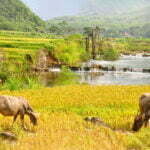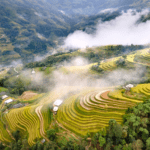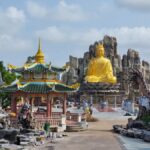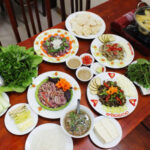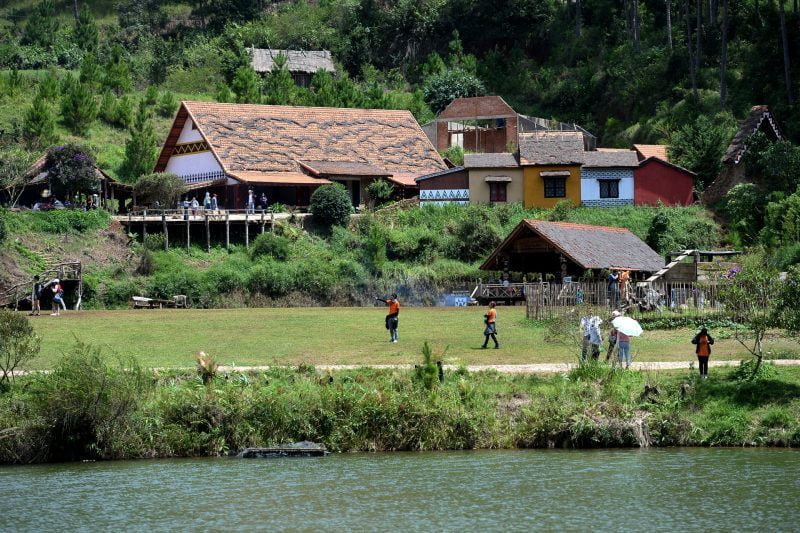
The modern life of the city is gradually creeping into the countryside as time passes, but fortunately, images of Vietnamese villages retain their beauty. Whatever settlement you visit on the S-shaped land will make you feel calm and at peace. Let’s explore the 10 most beautiful villages in Vietnam from North to South below!
Bat Trang Village – Hanoi
An ancient village placed on the Red River’s bank about 25 kilometers from Hanoi. For over 500 years, the village has been producing pottery. The local craftsmen have hundreds of skills in clay processing and fire control… They have created many beautiful ceramic works for local use, export, and art, etc.
Visitors to Bat Trang could meet the locals, visit the kilns, see how they make ceramics, or create paintings on ceramics… Visitors could also participate in some of the activities.
See more: Pu Luong Nature Reserve
Bat Trang Village, Hanoi
Duong Lam Ancient Village – Hanoi
Duong Lam village is located in Son Tay, nearly 60 kilometers or more than an hour’s drive from Hanoi.
This village became famous as the birthplace of two Vietnamese Kings: King Phung Hung (761-802) and King Ngo Quyen (896-944).
The trip to Duong Lam takes you through the Vietnamese countryside, with plenty of bamboo bushes and rice paddies along the way. You will see ancient houses, meet locals at their homes, and see them work on their farm.
It is a half-day trip that can be combined with a visit to Chua Thay Pagoda and Tay Phuong Pagoda to make a full day trip.
Duong Lam Ancient Village, Hanoi
Pom Coong Village – Mai Chau
Pom Coong is a must-see for anyone interested in immersing themselves in indigenous culture. “Pom Coong” translates to “hill” in Thai. Pom Coong Village is a hilly village mostly inhabited by Thai ethnic people who are well-known for their intricate embroidery techniques.
Pom Coong is a bustling village of traditional architecture and cultural activities, home to nearly 70 households and over 300 people. Thai people mostly live on stilts made of bamboo stalks, wooden pillars, and rattan leaves. The distance between the ground and the first floor is 2 meters, and there is a staircase at the side of the house that connects them.
Pom Coong sells a variety of exquisite handmade items such as bags, scarves, and purses, as well as other specialty cuisines. Sticky rice cooked in bamboo cylinders, “man” pig, and “can” liquor are among the most popular dishes. Also, don’t pass up the opportunity to stay in a homestay, join a traditional performance, and learn some mesmerizing dances from the sweet Thai girls.
Pom Coong Village, Mai Chau
Cat Cat Village – Sapa
Cat Cat village is one of Sapa’s largest villages and is home to the Mong ethnic group. The indigenous culture, which was formed in the middle of the 19th century, has been well preserved by its inhabitants. Every corner of the village is filled with cultural beauty and traditional crafts.
Mong people enjoy farming and weaving brocades of various sizes, colors, and patterns. Agriculture is important in the lives of the Mong people: a number of picturesque terraced fields can be found scattered throughout the village, where people grow rice and corn for a living. Mong women keep alive the tradition of weaving vibrant patterns of trees, leaves, flowers, and animals on their clothing.
A three-story house with po-mu wooden roofing is the Cat Cat Village’s traditional architecture. Throughout the year, the main door remains closed and is only opened for special occasions such as weddings, funerals, and New Year’s. There is a worship area, a storage floor, a sleeping area, a kitchen, and a guest welcoming area inside the house.
When visiting Cat Cat, make sure to take photos of the handicraft shops, the rustic Gem Valley homestay & cafe, the waterfall, traditional houses, and, most noticeably, the green terrace fields. Purchasing brocades as souvenirs is also a good way to support the locals.
Cat Cat Village, Sapa
Cua Van Fishing Village – Halong Bay
Cua Van is a fishing village in the heart of Halong Bay, Vietnam’s most popular tourist destination. Cua Van is a lovely stop on your bay cruise. Because you have so many other activities planned after this stop, time is limited, but you could take some photos, offer assistance to locals, and learn about their lives out here in Halong Bay. You will notice that Fisherman’s house is very simple, and you may wonder why.
Around 1,600 people live in four fishing villages in Halong Bay: Cua Van, Ba Hang, Cong Tau, and Vong Vieng in Ha Long City’s Hung Thang ward. They live on floating houses and rely on fishing and marine aquaculture (the cultivation of marine biota) to survive, scouring the shallow waters for 200 species of fish and 450 different types of mollusks. Many of the islands got their names as a result of how their unusual shapes were interpreted. Voi Islet (elephant), Ga Choi Islet (fighting cock), Khi Islet (monkey), and Mai Nha Islet are some examples (roof). The names of 989 of the islands have been assigned. Some of the islands are also home to birds and animals such as bantams, antelopes, monkeys, and lizards.
Cua Van Fishing Village, Halong Bay
Thanh Ha Pottery Village – Hoi An
The Thanh Ha Pottery Village is located in Quang Nam province’s Thanh Ha ward, just off the Thu Bon River.
The village opens every day at 8 a.m. and closes at 5:30 p.m., though they don’t officially close until 6p.m. Weekdays are preferable, and mornings are preferable to avoid the heat. Even when the tour groups arrived later in the afternoon—around 3 p.m.—the village did not feel crowded.
The pottery at Thanh Ha Pottery Village is particularly unique. Everything is handcrafted from terracotta clay extracted from nearby riverbeds and shipped worldwide.
The Village, just a short drive from Hoi An Old Town, is a great activity for those looking for a more authentic hands-on experience in Vietnam or those looking to get away from Hoi An’s crowded markets.
Thanh Ha Pottery Village, Hoi An
Sinh Village – Hue
One of the most well-known painting villages in Vietnam is Sinh Village, which is located in the country’s central region. The village, also known as Lai An Village, has been preserving a unique folk culture that dates back hundreds of years.
The painting technique used here is unique: special printing paper is pressed against an engraved woodblock, producing a black-and-white print on the paper. The paper is then hand-colored with vibrant colors and allowed to dry. The entire process is done by hand and takes a long time. Tourists are welcome to try their hand at painting with the assistance of experienced artisans.
The village is also well-known for its exotic wrestling festival, which takes place on January 10th, according to the lunar calendar. It is one of the most important spring festivals in Vietnam, attracting both domestic and international visitors.
Sinh Village, Hue
Chau Giang Village – An Giang
Another village with impressive handcraft traditions. Chau Giang Village is an ancient village known for its religious customs and traditional handicrafts that is still preserving and developing Cham cultural beauty.
The Cham are required to pray five times a day, either at home or at the mosque. Mosques are special places for Cham people. In mosques, they pray, celebrate special occasions, and even learn to write and read.
The Masjid mosque is a significant mosque in Chau Giang Village. The main color of Masjid mosque, like that of most other Islamic mosques, is white. Sun and crescent moon symbols can be found here and there, representing the old Islamic culture.In accordance with Islamic regulations, you will be required to wear a scarf to cover your head.
The Cham people of Chau Giang Village are well-known for their incredible handicraft techniques. They create lovely sarongs, scarves, hats, coats, bags, and purses. Local girls are taught to weave brocades at the age of 12 and are responsible for weaving a whole family’s clothing ever since. You will be able to learn how to use a weaving loom and make your own cloth with the help of these artisans. Definitely worth a try!
Chau Giang Village, An Giang
Mui Ne Fishing Village – Binh Thuan
The fishing village of Mui Ne is a beautiful fairy-like village with a typical sea flavor, located along Huynh Thuc Khang Street, one of the romantic streets of Phan Thiet city.
Mui Ne fishing village has the pristine and idyllic beauty of a coastal fishing village, with fine white sand stretches and a smooth blue sea that gives visitors a sense of peace and tranquility the moment they set foot here.
From above, a whole coastline stretches out with hundreds of ships moored and interwoven with basket boats in the sea’s green color. The atmosphere here becomes bustling every morning as boats start competing to dock and people rush to exchange each batch of fish and shrimp.
This place provides a unique color of marine life at all times of the day. The fishing village’s sunrise is vibrant, with sparkling lights on the sea. The fading sun creates the scenery of a beautiful fairy-like village as it falls with the fading sun full of dreaming and poetry.
Mui Ne Fishing Village, Binh Thuan
Sa Dec Flower Village – Dong Thap
If you’re wondering where the beautiful flower photos come from, go to Sa Dec Flower Village. It is one of South Vietnam’s largest flower suppliers, with 500 hectares of various types of flowers and bonsai.
Sa Dec Flower Village – Dong Thap
In the lunar calendar, the best time to visit Sa Dec Flower Village is December. Flowers will be in full bloom by then, with vibrant colors and fragrances. Visit the village at the beginning of December or before December 23 (lunar calendar), when flowers are harvested and transferred to Saigon to meet New Year’s demand.
When you visit Sa Dec Flower Garden, you will be amazed by the vast beds of various colors that feature hundreds of flowers, plants, herbs, and bonsai. After you’ve finished flower-watching and photographing, you can go to nearby tourist attractions such as Huynh Thuy Le Ancient House and Kim Hue Pagoda. Don’t forget to fill your empty stomach with tasty Hu Tieu, the famous Southern Vietnamese cuisine.
Post a Comment
You must be logged in to post a comment.


